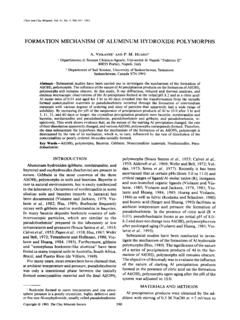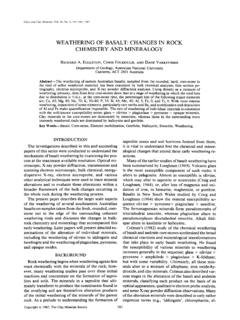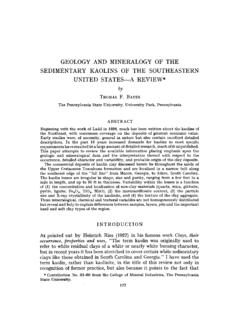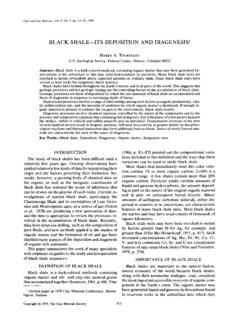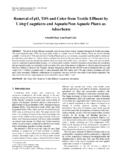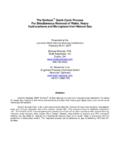Transcription of EFFECT OF A1 AND ORGANIC ACIDS ON THE …
1 Clays and Clay Minerals, Vol. 46, No. 4, 453-465, 1998. EFFECT OF A1 AND ORGANIC ACIDS ON THE SURFACE chemistry OF kaolinite DAVID B. WARD 1 AND PATRICK V. BRADY 2 L Jacobs Engineering Group Inc., 2155 Louisiana Blvd. Suite 10000, Albuquerque, New Mexico 87110 2 Geochemistry Research (MS 0750), Sandia National Laboratories, Albuquerque, New Mexico 87185 Abstract--The cause of pH and ionic strength-dependent proton and hydroxyl adsorption onto kaolinite is specific binding at edge A1 and Si sites, and it can be modeled as a function of temperature with a triple layer model (TLM) of the mineral-solution interface. Exchange of A1 for protons and hydroxyls is observed at low pH, with a stoichiometry approaching 1:3 (AI:H+). Adsorption of ORGANIC ACIDS from dilute solutions depends on: 1) solution pH; 2) the functionality of the acid ; and, to a lesser extent, 3) temperature.
2 Such adsorption may occur primarily at A1 sites exposed on kaolinite edges, as indicated by sorption experiments on the constituent oxides, where negligible sorption was observed on SiO2 (quartz), but was significant on A1203 (corundum) surfaces . Under similar conditions, oxalate adsorbs more strongly than acetate or formate to aluminol sites. Key Words--Aluminum, ORGANIC ACIDS , Oxalate, Surface Change. INTRODUCTION Interactions between clay mineral surfaces , hydrox- yls and ORGANIC molecules control the geochemical cy- cling of a number of trace and major elements in soils and, presumably, at higher temperatures, during dia- genesis. ORGANIC ACIDS , which are often more abundant than either protons or hydroxyls, have specifically been argued to accelerate both the dissolution (Wie- land and Stumm 1992) and growth (Siffert 1962; Small 1992) of clay minerals in soils and during dia- genesis.
3 In other words, adsorbed ORGANIC ACIDS appear to be reactive intermediates critical to the addition or removal of mineral components (AI, Si, etc.) from the bulk clay mineral phase. The mechanistic steps by which ORGANIC ACIDS facilitate the dissolution and/or growth of silicate minerals remain unclear. This is par- ticularly true for growth. There exists no method for predicting a priori 1) the extent of adsorption of a given ORGANIC ligand on a particular clay mineral sur- face or 2) whether the ligand will accelerate (or di- minish) dissolution (or growth). Answers to each of these questions must depend on both the chemical reactivity of the various ORGANIC functional groups and on the intrinsic reactivity of the clay mineral surfaces . Generally those ligands that complex strongly with a given metal in solution also bind strongly and accel- erate the corrosion of the same metal (hydr)oxide (Grandstaff 1986; Stumm et al.
4 1983). For silicates, the correlation between complexation, binding and corrosion is apparently more complex (Brady and House 1996). ORGANIC ligands have been found to have less EFFECT on dissolution rates of minerals than one might predict from aqueous speciation (Mast and Drever 1987), suggesting that crystallochemical fac- tors deserve to be examined in further detail. On the mineral surface side, kaolinite is uniquely suited for examining multi-oxide- ORGANIC acid interactions, since 1) it contains octahedral A1203 and tetrahedral SiO2, 2 of the primary functional groups exposed at clay sur- faces; 2) it contains no easily leached cations; 3) its (hydr)oxide components exist in a variety of distinctly different structural environments (such as basal planes and edges); and 4) there is minimal substitution of variable-valence cations.
5 Here we first measure proton adsorption/desorption onto kaolinite (as well as quartz and corundum) and calibrate a model for kaolinite surface chemistry in ORGANIC -free solutions, We then measure the exchange of AI for surface protons. Finally, we measure adsorp- tion of formate, acetate and oxalate onto kaolinite and use these results to examine ORGANIC anion- kaolinite surface interactions. EXPERIMENTAL METHODS Adsorbents Georgia kaolinite (KGa-1; from the Source Clay Minerals Repository, University of Missouri) was used without additional pretreatment. Its specific surface area was found to be m2/g. Quartz (Min-U-Sil 5; from Silica, Berkeley Springs, West Virginia; crushed at Mill Creek, Oklahoma) was studied as an analog for the tetrahedral Si sites in kaolinite . It was acid -washed before use and had a specific surface area of m2/g.
6 Reagent-grade a-Al203 (corundum) was obtained from Fisher Scientific for study as an analog for kaolinite 's octahedral alumina sites. It was also acid -washed before was use and had a specific surface area of me/g. All surface areas were measured by N2-Brunauer-Emmett-Teller (BET) using standard methods on a Micromeritics ASAP 2000. Concomitant measurements of standards of specific surface areas similar to those of the adsorbents suggest an accuracy Copyright 9 1998, The Clay Minerals Society 453 454 Ward and Brady Clays and Clay Minerals of _+5% (l~r). Each adsorbent was determined by X- ray diffraction (XRD) to be mineralogically pure. Corundum was separated from the rinse water by gravity settling, whereas centrifugation was required for the quartz powder once the pH was > Finally, the adsorbents were dried at 110 ~ driving off the last traces of HC1, and stored in air.
7 Potentiometric Titrations Potentiometric titrations of suspensions of an adsor- bent in NaC1 electrolyte were used to infer surface charge as a function of pH by comparing the measured pH with the net concentration of acid ((7,) added (treat- ing base as negative acid ). The proton balance of such a system is: C, = [H *] - [OH-] + [>SOH+2] - [>SO ] [1] where >SOH+2 and >SO- are the protonated and de- protonated surface species (see below), respectively. This may be rearranged and stated in terms of mea- sureable parameters as: Kw 10 pn 10 -pn er 0 = C~ + [2] "/on "YH ~ where cr 0 is the net surface charge, Kw is the dissoci- ation constant for water and ~ut and ~ou- are activity coefficients (calculated using the Davies equation (Da- vies 1962)). Titrations were performed in a loosely sealed poly- ethylene vessel partially immersed in a constant-tem- perature water bath.)
8 The headspace of the vessel was continuously purged with humid Ar to exclude atmo- spheric CO2. The pH was monitored by a glass com- bination electrode (Orion ROSS 8102), and was ad- justed by addition of degassed reagents ( M HC1 and NaOH) using computer-controlled syringes with a resolution of 10 -6 L (measurement of reagent volumes is not thought to have been a significant source of error). Temperature was monitored using a standard, Hg-filled thermometer (-20 to 110 ~ Fisher #14- 983-17a) calibrated at 0 and 95 ~ (the local temper- ature at which water boils). The pH electrode was cal- ibrated at the temperature of interest using commer- cially prepared buffers (Fisher Scientific) and their reported pH values (4, 7 and 10 at ~ Including buffer uncertainties and electrode drift, pH measure- ments were probably accurate to within _+ or bet- ter (1~).)
9 To begin a series of titrations, L of M NaC1 was placed in the reactor and stirred rapidly un- der Ar purge until its pH stabilized (usually near ). Enough adsorbent was then added to give a surface concentration of 120-500 m 2 L -t, and was allowed to equilibrate until pH was again stable (30-90 min). Ti- trations then commenced with incremental addition of HC1 until the lowest desired pH was reached, followed by incremental addition of NaOH until the highest de- sired pH was reached, and finally incremental addition of HC1 again to return to the lowest desired pH. A known amount of solid NaC1 was added to increase the ionic strength to M, and the NaOH and HC1 titrations were repeated. Ideally, each increment of re- agent would have changed the pH of the system by pH units. The pH was recorded when a stable reading was reached, after 1-4 min.
10 Each "leg" of the titration required 40-90 min. Thus, only fast proton- ation/deprotonation reactions were measured, with lit- tle influence from the slow process that occurs over several hours (Dzombak and Morel 1990). Reagents were calibrated with a precision of better than _+ (1 standard error, n = 4) M either by standardizing against potassium hydrogen phthalate (KHPh), or by titrating a known volume of electrolyte. In the first method, solutions containing a known amount of KHPh were titrated to an endpoint of pH , allowing the concentration of the NaOH to be cal- culated. In turn, the NaOH was used to neutralize a known volume of HC1, fixing its concentration as well. Volumes were measured using the same computer- controlled syringes as were used in the potentiometric titrations. In the second method, the potentiometric ti- tration apparatus was used to measure the volumes of reagents needed to adjust the pH of L of M NaC1 from 4 to 10 and back again.

